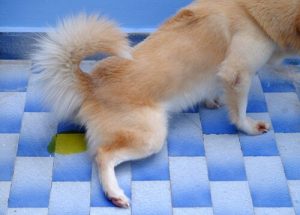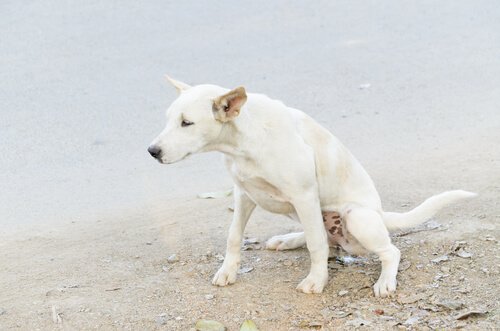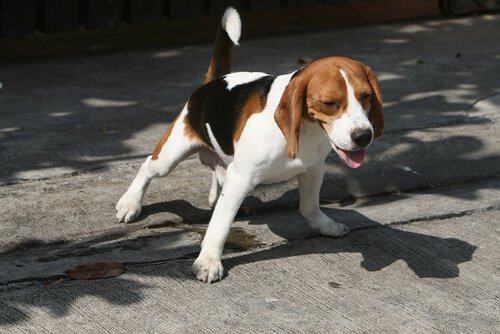Urinary Incontinence in Dogs

If your dog can’t “hold it in,”, he mist have a bladder problem. It’s important to learn about urinary incontinence in dogs you’ll know why it happens and how to treat it. This article provides valuable information on this condition in dogs.
Causes and symptoms of urinary incontinence in dogs
This problem often appears as small “drops” of urine or sometimes as full stream. Although, this condition is most common in old dogs, large breeds, and spayed females, it can happen to any dog.
To begin with, you’ll need to know how to recognize the symptoms, other than involuntary urination. For example, check if your dog is often licking his genitals, if the area between the lower abdomen and hind legs is always wet, or if there’s any swelling or redness around the vulva or penis.
Also, check your dog’s personal belongings to see if there is any urine stains or puddles on his bed, sheets, toys, or accessories. This kind of urine doesn’t always have foul stench. That’s why you need to know the main causes of urinary incontinence in dogs. Obesity and old age are the most common symptoms, but not the only ones.

Most male dogs don’t have any urinary problems after getting neutered, but some females may experience leakage after being spayed. The problem usually goes away after learning how to control their bladder muscles again.
Other possible causes of urinary incontinence in dogs are:
- Hormonal imbalances
- Spinal cord injuries
- Urinary tract infections
- Prostate diseases (in males)
- Birth defects
- Overactive bladder syndrome
Finally, you must take your dog’s breed into consideration. Urinary incontinence is especially common in Bobtails, Dobermans, Cocker Spaniels, and German Shepherds.
Treatment for urinary incontinence in dogs
Once you’ve determined that your dog has this problem, or suspect that he does, you should immediately take him to see a vet. They’ll examine your dog and find out the cause of his involuntary urination.

The vet will probably run physical exams, urinalysis, and urine culture to check your dog for any infections. If your dog can’t hold in his urine due to drinking a lot of water, the vet might also run a blood test to rule out any conditions that cause thirstiness, such as diabetes.
Likewise, the vet might run other tests such as an abdominal ultrasound to see if your dog has some kind of abdominal or bone-related injury.
You can treat urinary incontinence in dogs with certain medicines. Sometimes estrogen hormones like estriol work well because they block the passageway for urine in the dog’s urethra. However, this method is for spayed females.
Phenylpropanolamine is a non-hormonal medication some vets use that strengthens the sphincter muscles. Most medications are oral (pills or drops). If none of them work, your vet might choose to do collagen injections or surgery.
To prevent your dog from urinating everywhere (whether sick or not), you can place some more sheets or towels over your dog’s bed, take him out for walks more often, or put some special diapers on him. It’s also important not to forget to make sure you maintain your dog’s hygiene to prevent him from contracting any infections or swelling in the genitalia.
If your dog can’t “hold it in,”, he mist have a bladder problem. It’s important to learn about urinary incontinence in dogs you’ll know why it happens and how to treat it. This article provides valuable information on this condition in dogs.
Causes and symptoms of urinary incontinence in dogs
This problem often appears as small “drops” of urine or sometimes as full stream. Although, this condition is most common in old dogs, large breeds, and spayed females, it can happen to any dog.
To begin with, you’ll need to know how to recognize the symptoms, other than involuntary urination. For example, check if your dog is often licking his genitals, if the area between the lower abdomen and hind legs is always wet, or if there’s any swelling or redness around the vulva or penis.
Also, check your dog’s personal belongings to see if there is any urine stains or puddles on his bed, sheets, toys, or accessories. This kind of urine doesn’t always have foul stench. That’s why you need to know the main causes of urinary incontinence in dogs. Obesity and old age are the most common symptoms, but not the only ones.

Most male dogs don’t have any urinary problems after getting neutered, but some females may experience leakage after being spayed. The problem usually goes away after learning how to control their bladder muscles again.
Other possible causes of urinary incontinence in dogs are:
- Hormonal imbalances
- Spinal cord injuries
- Urinary tract infections
- Prostate diseases (in males)
- Birth defects
- Overactive bladder syndrome
Finally, you must take your dog’s breed into consideration. Urinary incontinence is especially common in Bobtails, Dobermans, Cocker Spaniels, and German Shepherds.
Treatment for urinary incontinence in dogs
Once you’ve determined that your dog has this problem, or suspect that he does, you should immediately take him to see a vet. They’ll examine your dog and find out the cause of his involuntary urination.

The vet will probably run physical exams, urinalysis, and urine culture to check your dog for any infections. If your dog can’t hold in his urine due to drinking a lot of water, the vet might also run a blood test to rule out any conditions that cause thirstiness, such as diabetes.
Likewise, the vet might run other tests such as an abdominal ultrasound to see if your dog has some kind of abdominal or bone-related injury.
You can treat urinary incontinence in dogs with certain medicines. Sometimes estrogen hormones like estriol work well because they block the passageway for urine in the dog’s urethra. However, this method is for spayed females.
Phenylpropanolamine is a non-hormonal medication some vets use that strengthens the sphincter muscles. Most medications are oral (pills or drops). If none of them work, your vet might choose to do collagen injections or surgery.
To prevent your dog from urinating everywhere (whether sick or not), you can place some more sheets or towels over your dog’s bed, take him out for walks more often, or put some special diapers on him. It’s also important not to forget to make sure you maintain your dog’s hygiene to prevent him from contracting any infections or swelling in the genitalia.
This text is provided for informational purposes only and does not replace consultation with a professional. If in doubt, consult your specialist.







